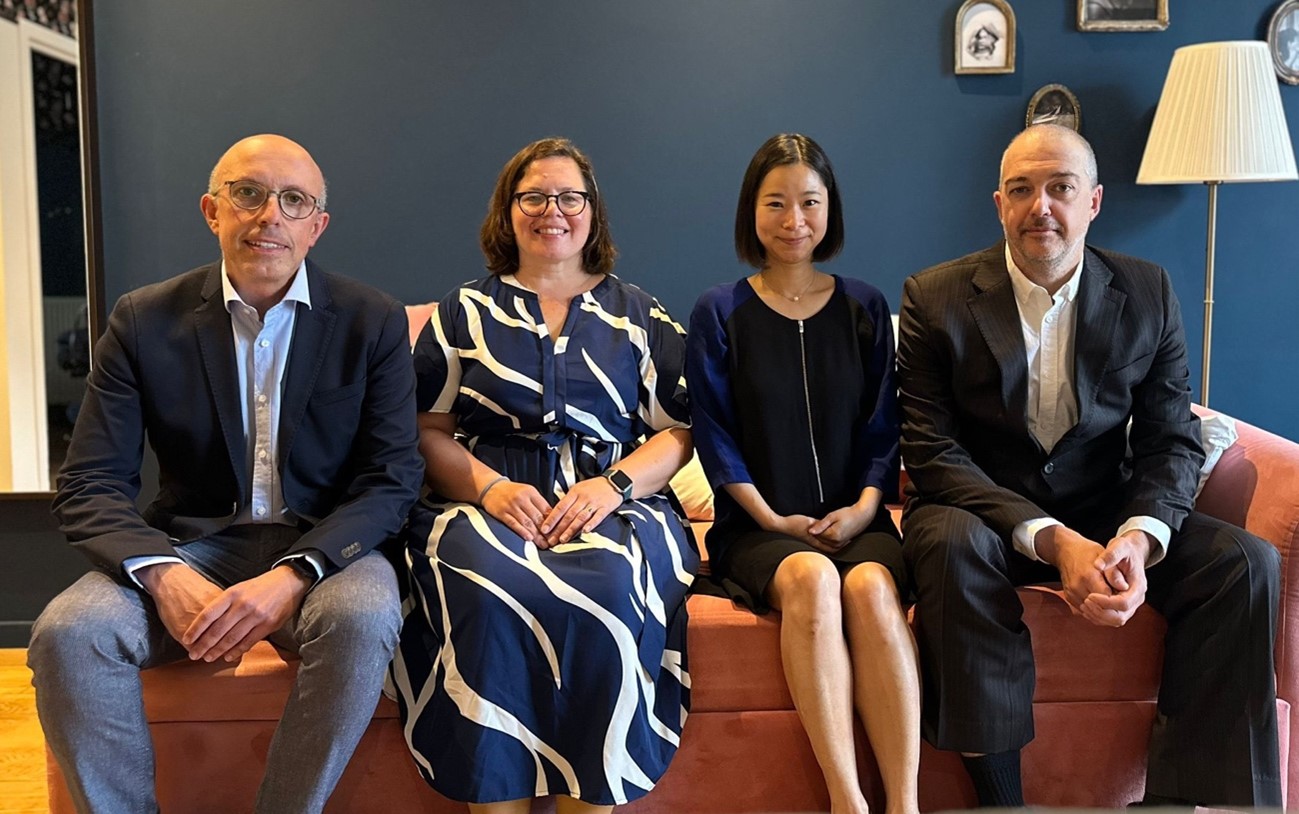IGFAE researcher Jaime Álvarez-Muñiz gets a Synergy Grant for a new neutrino detection experiment



06.11.2025

Jaime Álvarez-Muñiz, researcher at the Instituto Galego de Física de Altas Enerxías (IGFAE),has been awarded with Synergy Grant in the call of the European Research Council (ERC), which funds ambitious scientific proposals developed in collaboration among staff from different institutions. The project HERON (Hybrid Elevated Radio Observatory for Neutrinos) will receive 14 million euros with the goal of detecting ultra-high-energy neutrinos, some of the most elusive and energetic particles in the cosmos.
The basis of the idea is to open a new window for the observation of the Universe through the construction of a new observatory in a mountainous area in the Argentine province of San Juan, near the Andes. HERON will be the most sensitive instrument in the world for the detection of these ultra-energetic neutrinos. In addition to the IGFAE, HERON will involve research centers from France (Institut d’Astrophysique de Paris and Université Sorbonne) and the United States (Pennsylvania State University), together with local support from Argentina’s Comisión Nacional de la Energía Atómica (CNEA).
The detection of neutrinos is one of the main challenges in astrophysics. They are very special elementary particles, different from all others, since they have no electric charge, their mass is tiny, and they barely interact with the rest of matter. For this reason, they can cross galaxies, stars, and planets without colliding with anything or disintegrating. Because of this, they are known as the “ghost particles.”
Specifically, ultra-high-energy neutrinos come from some of the most violent phenomena in the universe, such as supernovae, neutron star collisions, or black hole jets. At these energies, it is believed that neutrinos are produced at their sources from interactions of cosmic rays, charged particles that bombard the Earth from all directions and are detected in experiments such as the Pierre Auger Observatory, also located in Argentina, in which the IGFAE also participates.
The detection and analysis of this type of neutrino could offer very important information about the origin of these extreme events. However, for this, gigantic detectors are needed, capable of observing large areas where neutrino interactions can occur, since their flux and interaction probability are very low.
In this context, HERON is set to take a further step, as it will have a sensitivity between 10 and 20 times greater than any current experiment. The observatory planned in Argentina will consist of a network of antennas distributed along 72 kilometers, which will observe the brief radio flash that neutrinos can produce when they impact the Earth’s crust, especially those with an energy above 10¹⁷ electronvolts (eV).
HERON’s antennas will operate in the frequency range of tens to hundreds of megahertz (MHz), similar to that of frequency modulation (FM), but with the ability to detect extremely brief signals, lasting tens of nanoseconds. This method has already proven effective in experiments such as BEACON or GRAND, in which the same team that has now obtained the Synergy Grant also participates.
Another advantage of HERON is that the antenna system, simple and cost-effective, can be installed over vast areas of land, maximizing the extent over which possible neutrino interactions can be observed.
This new experiment will also be integrated into the global network of multi-messenger astronomy observatories, in coordination with detectors of gravitational waves, gamma rays, and other types of neutrinos. The possibility of obtaining information about astrophysical phenomena through various signals has in recent years opened enormous possibilities in the exploration of the universe.
“For more than 25 years, the Astroparticle Physics team at IGFAE has been at the forefront in the study of the detection of cosmic rays and ultra-high-energy neutrinos, pioneering the development of models that describe how tau neutrinos interact within the Earth, how the resulting tau particles emerge and produce cascades of particles in the atmosphere, and how these cascades develop, generating radio signals that can be detected with antennas from several kilometers away,” summarizes Jaime Álvarez-Muñiz.
In this framework, “the capabilities of the IGFAE team will be essential in the final design and optimization of HERON, as well as in understanding its future data, helping to reconstruct the properties of the detected neutrinos and distinguish them from cosmic rays, which are much more abundant,” emphasizes the researcher. The simulation tools and models developed at the IGFAE have already played a key role in very-high-energy particle detection experiments, paving the way for the HERON proposal.

Jaime Álvarez-Muñiz, Stephanie Wissel, Kumiko Kotera and Olivier Martineau are the principal investigators of HERON
In addition to Jaime Álvarez and his team at IGFAE, HERON brings together four principal investigators and their respective groups. The project is coordinated by astrophysicist Kumiko Kotera, from the Institut d’Astrophysique de Paris, belonging to the Centre National de la Recherche Scientifique (CNRS) of France, and also includes as principal investigators Stephanie Wissel (Pennsylvania State University, United States) and Olivier Martineau, from the Université Sorbonne in Paris.
Jaime Álvarez-Muñiz
Jaime Álvarez-Muñiz graduated in Physics from USC in 1994 and obtained his PhD in astroparticle physics in 1999. He carried out postdoctoral stays at the University of Wisconsin–Madison and at the Bartol Research Institute of the University of Delaware in the United States, before returning to USC as a Ramón y Cajal researcher in 2004. He became an associate professor in 2010 and a full professor in 2023.
His research focuses on astroparticle physics, specifically on ultra-high-energy cosmic rays (UHECR) and neutrinos, with the aim of identifying the sources, nature, and acceleration mechanisms of these particles, which arise from the most extreme astrophysical phenomena. He is a member of the Pierre Auger collaboration, a cosmic-ray detection observatory located in Argentina, co-directing since 2008 the neutrino analysis efforts, and has also participated in numerous experimental initiatives for the use of radio waves in the detection of very-high-energy cosmic particles.
Throughout his career he has published nearly 200 articles, supervised seven doctoral theses—with three more in progress—and made over 50 presentations at international conferences. He has been principal investigator of various national and regional projects and coordinates the Cosmic Particles and Fundamental Physics research area at IGFAE.
About the Synergy Grant call
The Synergy Grant call is one of the most prestigious funding lines of the European Research Council (ERC). Specifically, it promotes collaboration among high-level research teams in different countries, allowing them to combine their knowledge, experience, and resources to push the boundaries of scientific discovery. In this call, the ERC has selected 66 proposals across Europe, which will receive a total of 684 million euros.
The Instituto Galego de Física de Altas Enerxías (IGFAE) is a research center created in 1999 by the University of Santiago de Compostela and the Xunta de Galicia. It was born with the goal of coordinating and promoting scientific and technical research in the fields of High Energy, Particle, and Nuclear Physics, and related areas such as Astrophysics, Medical Physics, or Instrumentation. It hosts around 140 people who participate in experimental facilities such as CERN, the Pierre Auger Observatory, LIGO, or GSI/FAIR, among others, and also includes internationally recognized groups in theoretical physics.
The center has been accredited twice (2017 and 2023) as a María de Maeztu Unit of Excellence by the State Research Agency of the Government of Spain. It is also part of the CIGUS network of the Xunta de Galicia, which certifies the quality and impact of its research. It is co-financed by the European Union through the Galicia Feder 2021–2027 Program.